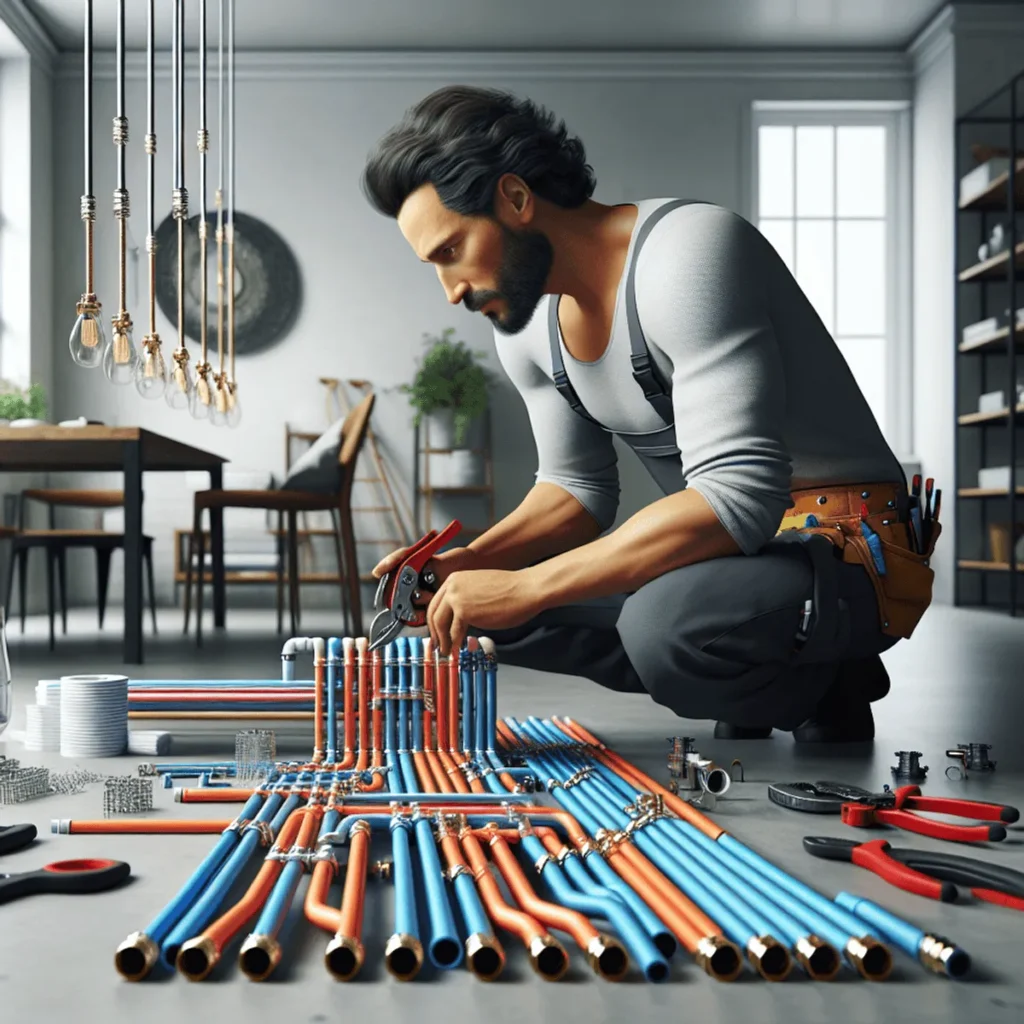Regarding plumbing solutions, two names often come up: ProPress and PEX. Each offers unique benefits and is suited for different types of projects. ProPress uses press fittings to create secure connections in copper piping, making it a popular choice for commercial and institutional settings. On the other hand, PEX is a flexible plastic piping material favored in residential plumbing for its ease of installation and resistance to freezing.
Choosing the right piping material is crucial for the success of your project. The correct choice can save time, reduce costs, and ensure long-term reliability.
In this article, you will learn:
- Key features and advantages of both ProPress and PEX systems
- Limitations associated with each system
- A side-by-side comparison of cost, installation process, and durability
- Practical applications to help you decide which system best suits your project needs
Understanding ProPress
ProPress is a game-changing plumbing solution that has become popular for its efficiency, especially in commercial and institutional settings. Unlike traditional plumbing methods, ProPress uses press fittings to create secure, watertight connections in copper piping without opening flames or soldering materials.
Advantages of ProPress System
Speed and Efficiency in Installation Processes with ProPress
One of the standout features of the ProPress system is its speed of installation. Traditional soldering requires significant preparation and skill, including cleaning the pipe ends, applying flux, and using a torch to melt solder into the joint. In contrast, ProPress fittings can be installed quickly using a pressing tool that mechanically secures the connection. This reduces installation time significantly.
- Time Savings: A typical soldered joint can take several minutes to complete, while a ProPress fitting can be installed in under 30 seconds.
- Reduced Labor Costs: The faster installation process means less time on-site, translating to lower labor costs.
- Consistency: The mechanical press ensures consistent connections every time, reducing the likelihood of leaks due to human error.
Ideal Applications for Commercial and Institutional Construction Projects
ProPress is particularly well-suited for commercial and institutional projects where time is of the essence. The ability to quickly complete installations without compromising on quality makes it an attractive option for these environments.
- Large-Scale Projects: Hospitals, schools, and office buildings benefit from the rapid deployment of ProPress systems. For instance, design standards for such institutions can be easily met with this system.
- Renovations: In existing structures where downtime must be minimized, ProPress offers a swift solution without disrupting operations.
Safety Advantages Over Traditional Soldering Methods
Safety is another critical advantage when choosing ProPress over traditional methods. Soldering involves open flames which pose multiple risks such as fire hazards and toxic fumes. These risks are mitigated by the ProPress system.
- No Open Flames: Eliminates fire hazards associated with soldering torches.
- Reduced Health Risks: Avoids exposure to harmful substances like lead-based solders and flux fumes.
Using ProPress also means fewer tools are required on-site. This not only simplifies logistics but also reduces potential safety concerns related to handling hazardous materials.
In summary, opting for ProPress provides several benefits:
- Faster installation times.
- Ideal for large-scale commercial projects.
- Enhanced safety with no open flames.
By focusing on speed, efficiency, and safety, ProPress becomes a compelling choice for modern plumbing needs in demanding environments. Furthermore, it’s worth noting that while copper piping is commonly used with ProPress fittings, John Guest fittings can also be utilized under certain circumstances. Additionally, when dealing with specific plumbing issues like water hammer effects in large systems, implementing water hammer arresters could be beneficial
Limitations of the ProPress System
ProPress offers numerous benefits, but it does have limitations that you should be aware of when considering plumbing connection methods. One significant concern is the long-term durability of O-ring seals used in ProPress connections. These seals are crucial for maintaining watertight integrity but can deteriorate over time due to various factors.
1. Material Aging
The O-ring material can age, leading to potential cracking or hardening, which compromises its sealing ability.
2. Movement and Vibration
In environments where there is consistent movement or vibration, the O-ring seals might shift or wear out quicker than expected.
Understanding these potential failure points is essential for long-term planning. While ProPress excels in speed of installation and efficiency in commercial settings, the longevity of its components must be considered.
The use of press fittings in copper piping systems brings advantages like no open flames during installation, reducing fire hazards. However, as with any system, periodic inspections and maintenance are vital to ensure continued performance. Comparing ProPress vs PEX, this aspect becomes particularly relevant, as PEX systems offer different longevity and reliability characteristics.
Understanding the PEX Plumbing System

Advantages of Using the PEX System
Flexibility and Ease of Installation
PEX, or cross-linked polyethylene, is renowned for its flexibility. Unlike rigid copper or PVC pipes, PEX can be bent around corners and through walls with minimal effort. This flexibility reduces the need for numerous fittings and joints, which can significantly cut down installation time and labor costs.
- Easier Routing: PEX pipes can be maneuvered through tight spaces without the need for extensive cutting or joining.
- Reduced Labor Costs: The ease of installation translates to fewer man-hours required on-site.
- DIY-Friendly: PEX is a popular choice for DIY enthusiasts due to its straightforward installation process.
Resistance to Freezing
One of the standout features of PEX piping is its resistance to freezing. In colder climates, traditional materials like copper are prone to freezing and bursting, leading to costly repairs.
- Expansion Capability: PEX can expand slightly if water inside freezes, reducing the risk of pipe bursts.
- Longevity: This resistance to freezing contributes to a longer lifespan in variable temperature environments.
- Minimal Insulation Needs: While insulation is still recommended, PEX’s inherent resistance offers an added layer of security.
Reduced Failure Points
Fewer joints mean fewer potential failure points. Traditional copper piping requires numerous fittings and joints, each representing a possible leak point.
- Continuous Runs: PEX can often be installed in continuous runs from one fixture to another without intermediate connections.
- Fewer Leaks: Reduced joints lower the chances of leaks developing over time.
- Cost Savings: Fewer materials needed for joints and fittings translate into cost savings both in materials and labor.
Limitations Associated with Using the PEX System
Despite its many advantages, there are some limitations associated with using PEX:
Compatibility Challenges
When integrating PEX into existing plumbing systems or when used alongside certain materials like CPVC, compatibility issues may arise.
- Material Compatibility: Some older systems may not be easily retrofitted with PEX without additional adapters or fittings.
- Building Codes: Certain local building codes may have restrictions on where and how PEX can be used.
- Zinc Corrosion (Yellow Brass): Fittings made from yellow brass can suffer from zinc leaching which may lead to corrosion over time.
Understanding these aspects ensures you make an informed decision when considering PEX for your plumbing needs, including its design specifications as outlined in the PEX Design Guide.
Limitations of Using the PEX System
PEX, or cross-linked polyethylene, is a flexible plastic piping solution commonly used in residential plumbing applications. While it has its advantages, there are some limitations to consider.
Compatibility Challenges
Integrating PEX into existing plumbing systems can be complex. When connecting PEX to materials like CPVC, issues may arise due to differing thermal expansion rates and chemical compatibility. Special fittings are often required to ensure secure connections between dissimilar materials, adding to the complexity and cost.
UV Sensitivity
PEX is susceptible to degradation when exposed to ultraviolet (UV) light. This characteristic necessitates careful handling and storage. Pipes must be shielded from direct sunlight during transport and installation, and any sections exposed to sunlight over long periods can become brittle and fail prematurely.
Permeability Concerns
While PEX is resistant to many chemicals, it is semi-permeable to oxygen. Oxygen diffusion through the pipe walls can lead to oxidation of metal components in the system, such as valves and fittings, potentially causing corrosion and reducing their lifespan.
Temperature Limits
Although PEX offers excellent resistance to freezing compared to traditional copper pipes, it has temperature limitations. It may not be suitable for applications requiring constant exposure to high temperatures exceeding 200°F (93°C).
These factors highlight the importance of understanding both the benefits and limitations of PEX when considering it for your plumbing project.
Comparing ProPress and PEX: A Side-by-Side Analysis

Cost Analysis: Which Plumbing Solution is More Affordable?
When you compare ProPress and PEX plumbing systems, cost is a crucial factor to consider. Each system has its unique initial costs and long-term expenses that can impact your project’s budget.
Initial Costs
ProPress:
- Fittings and Tools: ProPress fittings are generally more expensive than traditional soldering materials. The specialized pressing tools required for installation can also be costly, often ranging from $1,000 to $3,000.
- Labor Costs: Despite the higher material costs, the speed of ProPress installation can reduce overall labor expenses. Installers save time by avoiding the need for soldering, which translates into lower labor costs in many cases.
PEX:
- Materials: PEX piping is significantly less expensive than copper piping used in ProPress systems. The fittings are also cheaper, contributing to lower initial material costs.
- Tools: The tools required for PEX installation are generally less expensive than those needed for ProPress. Crimping tools or expansion tools typically range between $50 to $200.
- Labor Costs: Due to its flexibility and ease of installation, PEX often results in reduced labor times and costs compared to rigid copper piping systems.
Long-Term Expenses
ProPress:
- Maintenance: While ProPress connections are quick to install, they may require more maintenance over time due to concerns about the durability of O-ring seals. These seals can degrade or fail due to movement or aging, potentially leading to additional repair costs.
- Repairs: In case of failure, repairing or replacing ProPress fittings can be more expensive due to the cost of new fittings and the specialized tools needed.
PEX:
- Longevity: PEX pipes have a lifespan of over 50 years, minimizing long-term replacement costs. Their resistance to freezing reduces the likelihood of burst pipes and subsequent repairs.
- Maintenance: Fewer joints in PEX systems mean fewer potential failure points, translating into lower maintenance expenses over time.
- Compatibility Issues: Integrating PEX with existing plumbing systems or certain materials like CPVC might require additional adapters or fittings, which could add to the cost. However, solutions like SharkBite connectors can facilitate a seamless transition from copper to PEX.
Cost Breakdown Example
To illustrate the cost differences:
For a typical residential plumbing project:
- ProPress materials (copper pipes and fittings) might cost around $2,500-$3,000.
- Labor could add another $1,500-$2,000 due to the efficiency gained from quick installations.
For the same project using PEX:
- PEX materials might cost approximately $1,000-$1,500.
- Labor could be around $800-$1,200 due to easier handling and faster installation times.
Summary of Cost Considerations
- Initial Costs: ProPress has higher material costs but may offer savings in labor. PEX provides a more affordable option both in terms of materials and installation tools.
- Long-Term Expenses: Maintenance and repair costs favor PEX due to its longevity and fewer failure points. However, potential compatibility issues should
Installation Process: How Do They Stack Up?
When you compare ProPress and PEX plumbing systems, key differences in the installation process become evident. Here’s a step-by-step overview highlighting these distinctions.
ProPress Installation Process:
- Cutting the Pipe: Begin by cutting the copper pipe to the required length.
- Deburring and Cleaning: Deburr the edges and clean the pipe to ensure a secure connection.
- Fitting Placement: Insert the pipe into the ProPress fitting, ensuring it reaches the stop.
- Pressing: Use a ProPress tool to crimp the fitting, creating a watertight seal.
PEX Installation Process:
- Cutting the Pipe: Cut the PEX tubing to the desired length using a PEX cutter.
- Fitting Placement: Slide a crimp ring or cinch clamp over one end of the PEX pipe.
- Inserting Fitting: Insert a PEX fitting into the pipe end.
- Crimping/Cinching: Use a crimp or cinch tool to secure the ring/clamp around the fitting, ensuring it is tight and leak-proof.
Key Differences:
- Speed: ProPress connections are typically faster, especially for large-scale projects, due to fewer steps involved compared to soldering copper pipes. PEX offers comparable speeds but with more flexibility in maneuvering through tight spaces.
- Tools: ProPress requires specialized pressing tools which are relatively expensive, whereas PEX installations need simpler and more affordable crimp or cinch tools.
- Safety: ProPress eliminates open flames, reducing fire hazards. PEX also avoids flames but benefits from its inherent flexibility to reduce stress on fittings.
Moreover, it’s worth noting that each system has its own set of installation manuals that provide comprehensive guidance for successful implementation. For instance, Viega’s PureFlow Water System installation manual is an excellent resource for understanding detailed procedures related to PEX installations.
By comparing these steps and resources, you gain a detailed understanding of how these systems stack up against each other in practical scenarios.
Performance Over Time: Durability Considerations
When comparing ProPress and PEX plumbing systems, durability over time is a crucial factor. Lifespan expectations and maintenance requirements can greatly influence your choice.
ProPress:
- Lifespan: ProPress connections typically have a lifespan of 50 years or more. The reliability of these connections largely depends on the integrity of the O-ring seals.
- Maintenance: Regular inspections are advised to ensure the O-rings remain intact. Movement or aging can cause these seals to wear out, potentially leading to leaks. In some cases, such as homes built in the 1950s, it might be necessary to replace all plumbing due to wear and tear, which highlights the importance of regular maintenance (source).
PEX:
- Lifespan: PEX pipes boast a lifespan of over 50 years as well. This material’s resilience to chemical corrosion and scale buildup contributes to its longevity.
- Maintenance: PEX systems require minimal maintenance due to their resistance to freezing and fewer joints, which reduces potential failure points. However, exposure to UV light can degrade PEX piping, so it should be shielded from sunlight.
Durability considerations reveal that both systems offer long-term solutions but with different maintenance needs. ProPress may require more frequent checks on O-ring seals, while PEX demands protection from UV exposure.
Practical Applications: Choosing the Right System for Your Project Needs
When determining the best practices for selecting between ProPress or PEX plumbing solutions, consider:
- Project Type: For commercial projects requiring quick installations, ProPress may be ideal. PEX is often preferred in residential settings and retrofits.
- Budget: Assess initial costs and long-term expenses. PEX tends to be more cost-effective.
- Local Building Codes: Ensure compliance with local regulations, as some areas have specific requirements for plumbing materials.
Evaluating these factors will help you make an informed decision between ProPress vs PEX.
FAQs (Frequently Asked Questions)
What are the main differences between ProPress and PEX plumbing systems?
ProPress utilizes copper piping and press fittings, offering speed and efficiency in installation, especially in commercial settings. PEX, on the other hand, is made of cross-linked polyethylene, providing flexibility and ease of installation with resistance to freezing. Understanding these differences helps in selecting the right system for specific project needs.
What are the advantages of using the ProPress system?
The ProPress system offers several advantages including fast installation processes, ideal applications for commercial and institutional projects, and safety benefits over traditional soldering methods since it does not require open flames.
What limitations should I consider when using ProPress?
While ProPress has many benefits, it also has limitations such as concerns regarding the long-term durability of O-ring seals used in connections and potential failure points due to movement or aging of the copper piping.
Why is PEX considered a favorable plumbing material?
PEX is favored for its flexibility, ease of installation, and resistance to freezing. It also has fewer joints compared to other materials like copper piping, which reduces potential failure points in plumbing systems.
What compatibility issues might arise when using PEX?
When integrating PEX into existing plumbing systems, compatibility challenges may occur with certain materials like CPVC. It’s important to evaluate these issues to ensure a successful installation without leaks or failures.
How do ProPress and PEX compare in terms of cost and installation?
A detailed cost analysis reveals that both systems have different initial costs versus long-term expenses. The installation process also varies; while ProPress may be faster in commercial settings, PEX offers easier handling due to its flexibility. An in-depth comparison can help determine which solution is more affordable based on your specific project requirements.


Comments are closed